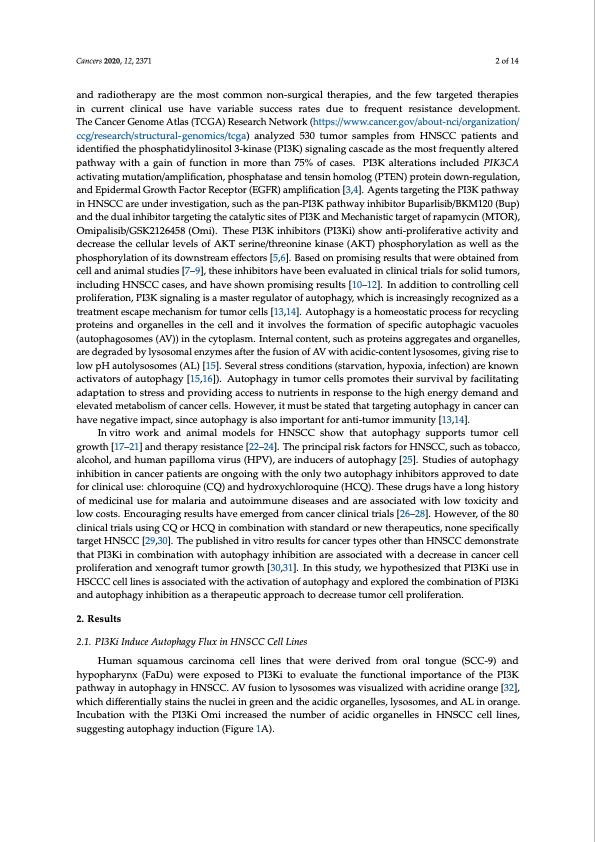
PDF Publication Title:
Text from PDF Page: 002
Cancers 2020, 12, 2371 2 of 14 and radiotherapy are the most common non-surgical therapies, and the few targeted therapies in current clinical use have variable success rates due to frequent resistance development. The Cancer Genome Atlas (TCGA) Research Network (https://www.cancer.gov/about-nci/organization/ ccg/research/structural-genomics/tcga) analyzed 530 tumor samples from HNSCC patients and identified the phosphatidylinositol 3-kinase (PI3K) signaling cascade as the most frequently altered pathway with a gain of function in more than 75% of cases. PI3K alterations included PIK3CA activating mutation/amplification, phosphatase and tensin homolog (PTEN) protein down-regulation, and Epidermal Growth Factor Receptor (EGFR) amplification [3,4]. Agents targeting the PI3K pathway in HNSCC are under investigation, such as the pan-PI3K pathway inhibitor Buparlisib/BKM120 (Bup) and the dual inhibitor targeting the catalytic sites of PI3K and Mechanistic target of rapamycin (MTOR), Omipalisib/GSK2126458 (Omi). These PI3K inhibitors (PI3Ki) show anti-proliferative activity and decrease the cellular levels of AKT serine/threonine kinase (AKT) phosphorylation as well as the phosphorylation of its downstream effectors [5,6]. Based on promising results that were obtained from cell and animal studies [7–9], these inhibitors have been evaluated in clinical trials for solid tumors, including HNSCC cases, and have shown promising results [10–12]. In addition to controlling cell proliferation, PI3K signaling is a master regulator of autophagy, which is increasingly recognized as a treatment escape mechanism for tumor cells [13,14]. Autophagy is a homeostatic process for recycling proteins and organelles in the cell and it involves the formation of specific autophagic vacuoles (autophagosomes (AV)) in the cytoplasm. Internal content, such as proteins aggregates and organelles, are degraded by lysosomal enzymes after the fusion of AV with acidic-content lysosomes, giving rise to low pH autolysosomes (AL) [15]. Several stress conditions (starvation, hypoxia, infection) are known activators of autophagy [15,16]). Autophagy in tumor cells promotes their survival by facilitating adaptation to stress and providing access to nutrients in response to the high energy demand and elevated metabolism of cancer cells. However, it must be stated that targeting autophagy in cancer can have negative impact, since autophagy is also important for anti-tumor immunity [13,14]. In vitro work and animal models for HNSCC show that autophagy supports tumor cell growth [17–21] and therapy resistance [22–24]. The principal risk factors for HNSCC, such as tobacco, alcohol, and human papilloma virus (HPV), are inducers of autophagy [25]. Studies of autophagy inhibition in cancer patients are ongoing with the only two autophagy inhibitors approved to date for clinical use: chloroquine (CQ) and hydroxychloroquine (HCQ). These drugs have a long history of medicinal use for malaria and autoimmune diseases and are associated with low toxicity and low costs. Encouraging results have emerged from cancer clinical trials [26–28]. However, of the 80 clinical trials using CQ or HCQ in combination with standard or new therapeutics, none specifically target HNSCC [29,30]. The published in vitro results for cancer types other than HNSCC demonstrate that PI3Ki in combination with autophagy inhibition are associated with a decrease in cancer cell proliferation and xenograft tumor growth [30,31]. In this study, we hypothesized that PI3Ki use in HSCCC cell lines is associated with the activation of autophagy and explored the combination of PI3Ki and autophagy inhibition as a therapeutic approach to decrease tumor cell proliferation. 2. Results 2.1. PI3Ki Induce Autophagy Flux in HNSCC Cell Lines Human squamous carcinoma cell lines that were derived from oral tongue (SCC-9) and hypopharynx (FaDu) were exposed to PI3Ki to evaluate the functional importance of the PI3K pathway in autophagy in HNSCC. AV fusion to lysosomes was visualized with acridine orange [32], which differentially stains the nuclei in green and the acidic organelles, lysosomes, and AL in orange. Incubation with the PI3Ki Omi increased the number of acidic organelles in HNSCC cell lines, suggesting autophagy induction (Figure 1A).PDF Image | Dual Inhibition of Autophagy Pathway as a Therapeutic Strategy

PDF Search Title:
Dual Inhibition of Autophagy Pathway as a Therapeutic StrategyOriginal File Name Searched:
cancers-12-02371.pdfDIY PDF Search: Google It | Yahoo | Bing
Cruise Ship Reviews | Luxury Resort | Jet | Yacht | and Travel Tech More Info
Cruising Review Topics and Articles More Info
Software based on Filemaker for the travel industry More Info
The Burgenstock Resort: Reviews on CruisingReview website... More Info
Resort Reviews: World Class resorts... More Info
The Riffelalp Resort: Reviews on CruisingReview website... More Info
| CONTACT TEL: 608-238-6001 Email: greg@cruisingreview.com | RSS | AMP |